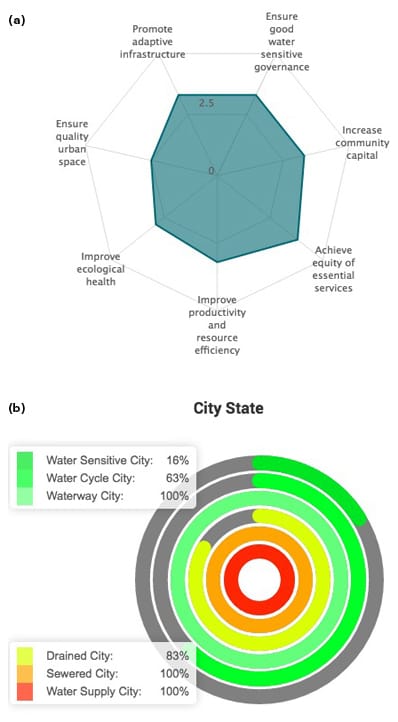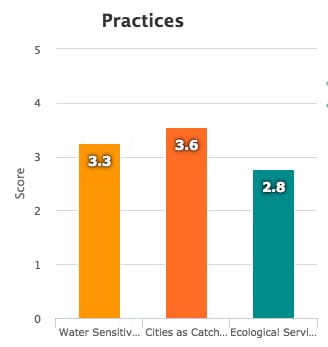Water Sensitive Cities Index
Key product features
The WSC Index framework comprises of 7 goals and 34 indicators, with a 1–5 rating scale for each indicator. The WSC Index indicators were developed based on characteristics identified as important in the literature, including timeliness, relevance, workability, along with indicators being easy to understand, comparable, credible, and transparent.
Users can access the WSC Index through a web platform that offers powerful visualisations of benchmarking results (Figure 1); the Index uses the City State Continuum framework (Figure 2) to benchmark the performance of a city, and to compare it to the performance of other cities.


The web-based platform allows users to filter results using a number of options:
- The water sensitive cities pillars framework (Wong and Brown, 2009) (Figure 3): If a city or region wants to invest in water sensitive practices with a focus on water resources and alternative water supplies, ecosystem services for the built and natural environments, or social and institutional capital, then results can be sorted and management actions prioritised using the three pillars of practice:
- Cities as water supply catchments: that is, access to water through a range of sources at different supply scales.
- Cities providing ecosystem services: that, is, the built environment supplements and supports the function of the natural environment.
- Cities comprising water sensitive communities: that is, socio-political capital for sustainability exists, and citizens contribute to decision-making.

- The four lenses of sustainability, resilience, liveability, and productivity (Figure 4): Users can filter results and align management actions with emphasis on delivering key water sensitive city outcomes:
- Sustainability, in relation to water, is the carrying capacity of the social, ecological, and economic environment and its ability to meet water-related needs.
- Liveability, in relation to water, is the capacity to meet the expressed societal needs of a community in the urban water context. These could include the need for potable water, public health, environmental health, human thermal comfort, and urban aesthetics.
- Resilience, in relation to water, is the capacity to maintain the function of a service under a wide range of conditions, including shocks and surprises, through recovery or adaptation.
- Productivity, in relation to water, is the capacity to generate economic value, directly or indirectly, from water-related actions.
The management actions align with the transition pathways framework (a synthesis of existing CRCWSC knowledge and research). The framework identifies critical elements needed to transition toward water sensitive cities and regions. Each element can be grouped into three transition pathways to distinguish between shifts in practices, structures, and cultures. The water sensitive cities transition pathways are:
- on-ground practices, or the on-ground activities that deliver water-related services (includes such aspects as water system planning, cost–benefit analysis, and monitoring and evaluation);
- enabling structures, or the formal and informal rules and frameworks (regulatory, policy, and economic) that structure urban water management and practices (including such aspects as vision and narrative, evaluation frameworks, policy, and strategy); and
- socio-political capital, or the commitment, knowledge, and skills needed from people and organisations to establish the enabling structures and implement water sensitive practices in the real world (includes such aspects as leadership, community connection, and learning cultures).
Each transition element has been assigned to one or more of the 34 indicators. This process enables key transition actions to be related to the objective(s) of each indicator for inclusion in a city’s regional transition strategy (action plan).

WSC Index concept
Listen to Chris Chesterfield introduce the concept of the WSC Index below.